Skoda Fabia TSI 1.2 TSI 110
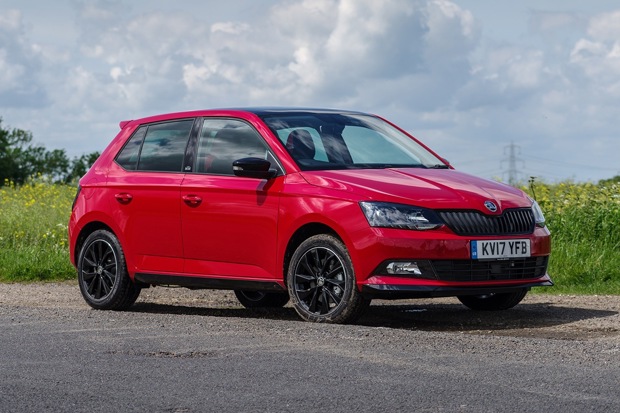
- Our new Skoda Fabia arrives
- Load capacity or catastrophe in our new Skoda Fabia
- Fabia follies
- A dog's day out
- The Fabia's divisive image
- Double trouble: Our red Fabia gets swapped for a green machine
- How does the Fabia stack up against the UK's favourite small hatchback?
- Simply Clever solutions in the Skoda Fabia
- Why I chose a DSG gearbox in the Skoda Fabia
- Safety systems and the Skoda
- The Skoda Fabia's uninspired interior
- Our Skoda Fabia goes home
Our new Skoda Fabia arrives
Georgia welcomes the Skoda Fabia into her life with open arms. But will she still love it in six months time?
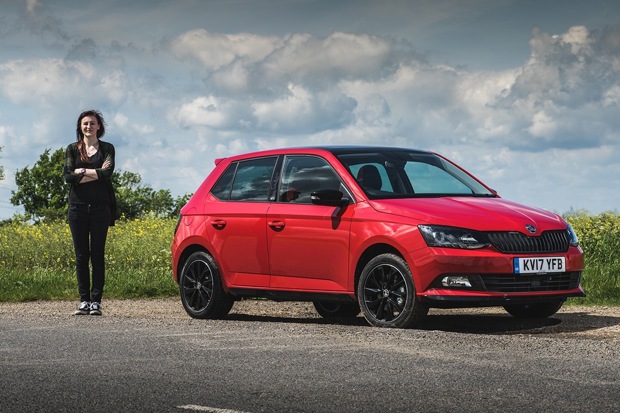
Date: 10 May 2017 | Current mileage: 633 | Claimed economy: 60.1 | Actual economy: 43.2
When I heard we were going to get a new Skoda Fabia Monte Carlo, I was quite excited. As someone who’s only been driving for a couple of years, I was thrilled to be given relatively free reign with configuring my Fabia. Except when I tried to add Telescopic Front Headlight Washers for £110, that was a swift no.
Before the Fabia I owned a 2003 Volkswagen Golf, silver of course, named Shadow after the old and wise Golden Retriever in Homeward Bound. Long story short, the car was written off, I earned the nickname Crashy McCrashFace (how endearing) and then drove a medley of spare cars for a few weeks.
So when I was told I’d be getting a new car for the Our Cars fleet I dreamt of being able to plug in my phone to stream music on the go. Finally – I thought – I would step into 2012 rather than the dystopian millennial nightmare I seemed to inhabit, where I had to convert and download music onto CDs. Then carefully pick what I wanted to listen to on long trips because the CD player was in the boot.
However, I seemed to evoke one of two main reactions when I excitedly told people about my new car. “I thought only old people bought Skoda,” they said. They being everyone – except my grandparents – who think the Fabia is fabulous (Fabialous?). The other reaction is from people who think Skoda cars are exclusively driven by taxi drivers.
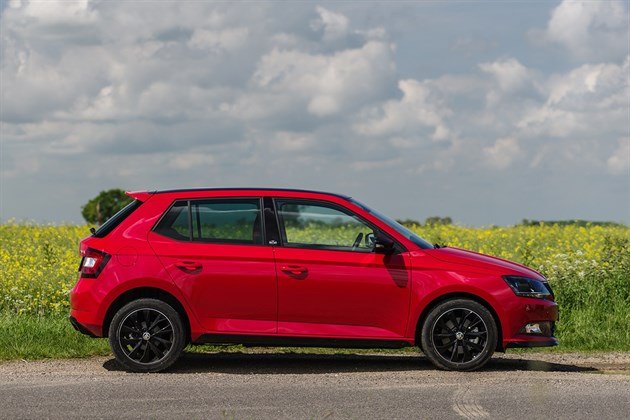
The Fabia looks every bit as good as I'd hoped it would
But when the Fabia Monte Carlo arrived, it looked every bit as good as I’d hoped. It’s highlighted with black elements, including the 16-inch alloy wheels, the panoramic sunroof, front grille and door mirrors. While the design isn’t to everybody’s taste, I quite like it. It’s described by Skoda as “the perfect car for those looking to make a statement”, and that it does.
The Monte Carlo also comes with a lot of decent gadgets as standard - including acoustic rear parking sensors, speedlimiter and smartphone connectivity via SmartLink. I’ve added some more extras like touchscreen navigation, a keyless entry and start system, light and rain assistant, the Simply Clever package and a spare wheel just because I can. Some of these, I’ve now found, are pretty pointless. For example, I rarely use the Nav because CarPlay allows me to connect my phone – including Maps which gives live traffic updates.
Now I’m not at my sharpest when I’m on my way to work because I moved recently and have to get up 30 minutes earlier to commute. Most of my brain capacity is used to complete basic tasks like not crashing my car, which means for the first week I kept thinking "wow isn’t this handy" about different features of the car without realising I paid £65 extra for them as part of the Simply Clever package.
Things like the pop-up umbrella beneath the passenger seat and the multifunction storage compartment which stops my phone rattling around in the cup holder are just nice little extras that make life slightly easier. That’s all for now, folks.
Load capacity or catastrophe in our new Skoda Fabia
The Fabia's load space is quickly tested when Georgia uses it to move some bulky furniture from the suburbs to wildest tractor land.
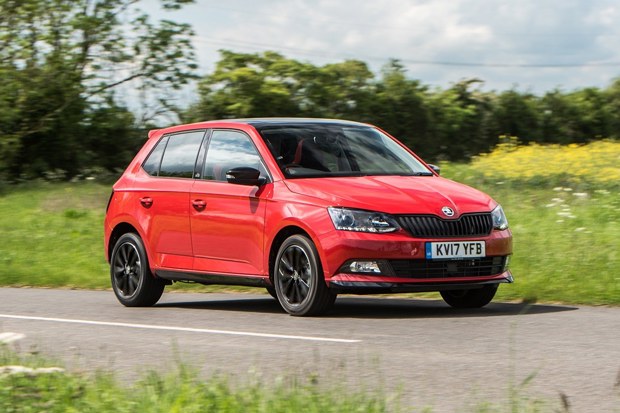
Date: 24 May 2017 | Current mileage: 886 | Claimed economy: 60.1 | Actual economy: 43.1
Straight away, my new Skoda Fabia was put to the test. Recently I moved house and, while I used a van to move most of the large items, I had to use the Fabia to shift some things before the van arrived. This meant that I got to know the ins and outs of my car’s load capacity very quickly.
I needed to move five long boxes, so obviously I had to fold the rear seats down. They don't fold completely flat, which is a bit annoying, but I also really needed to fold the front passenger seat. Unfortunately, reclining it enough to accomodate long loads isn't possible, because the rear seat backs get in the way when they're flipped down. So in the end I had to position the long boxes between the two front seats.
The Fabia is classed as a small hatchback, meaning that it isn’t exactly supposed to be used as a removal van. But I’m nothing if not an optimist. Also I really needed a wardrobe or I’d be living out of a floordrobe and that's not ideal.
That being said, the space in the relatively small Fabia is actually quite good. Eventually, after a whole lot of effort and careful application of my flawless loading technique, I managed to fit all my hastily bought furniture in. And there was still a lot of room to spare, surprisingly, albiet for more sensibly shaped items than flatpack wardrobes.
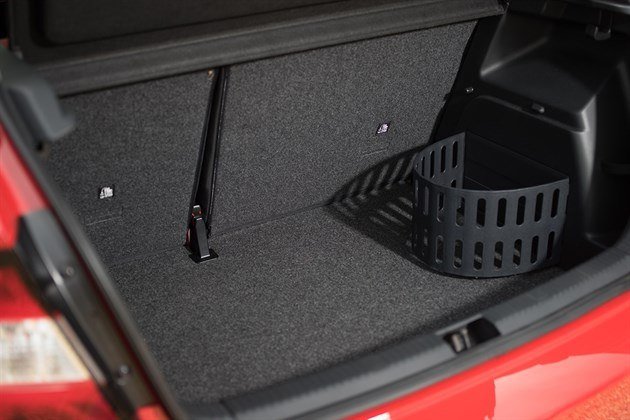
Where I put my groceries and, sometimes, entire wardrobes
I made it home with all the furniture, the car is intact and I still have a shred of my sanity. What more could I want? The new house is in a pretty rural area. Not so rural that we think Mary Berry is still presenting Bake Off (if only), but rural enough that the roads are fairly potholed.
The car has handled moving from commutes populated with roundabouts and Tesco Extras to tackling B roads very smoothly. The twists and turns of country roads are easy in the sportier Monte Carlo trim, the handling is nice and neat and 110PS is more than enough to cope with overtaking the ever-present pensioner too frightened to overtake the lorries holding back morning traffic.
As a city car, its tight turning circle and nimble manoeuvrability make it top-class, but for long trips on faster roads it can become uncomfortable. It offers impressive steering and cornering but the black 16-inch alloy wheels and sports suspension that come as part of the Monte Carlo trim make for a firm ride on bumpy roads.
So far, I’ve enjoyed the little Fabia a lot. But for a car that’s sold as the cheap alternative to rivals like the Volkswagen Polo, I’m not sure that the cheaper, bog-standard models would offer enough to compete. Only time will tell I suppose.
Fabia follies
After having the Fabia for a month, Georgia begins to notice little annoyances cropping up.
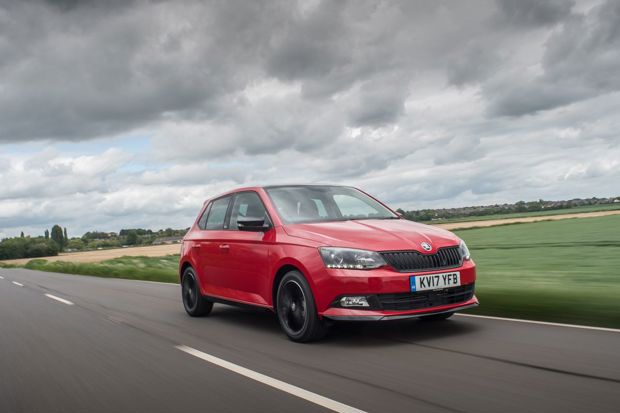
Date: 7 June 2017 | Current mileage: 1378 | Claimed economy: 60.1 | Actual economy: 45.2
I actually like the Fabia quite a lot. It drives well, is resonably priced and doesn’t look like your average small hatchback. However, having had the car for a few weeks now, I've started to notice a few things that irritate me.
Firstly, the CarPlay. In short, CarPlay is a function that allows the applications on your phone to be mirrored on the car's in-built display. Thereby allowing you to skip through music on your Spotify, use Google Maps, and to send and receive text messages safely using Siri. I was really looking forward to this feature because – as mentioned in my first review – this is my first car with anything but a basic radio.
The thing is, while CarPlay works 95 per cent of the time, every now and then it suddenly disconnects. Meaning that I lose everything that my phone had linked to my car. So, unless I want to pull over and enter the address details into my touchscreen navigation, I end up having to repeatedly plug in and unplug my phone until the system recognises it again.
One thing I have found to remedy this is to use a genuine Apple cable rather than a cheap, knockoff - like I was sometimes using. I also recently discovered that because CarPlay just mirrors the phone that's connected, it has the same funny quirks. For example, when it reads texts from my Grandma to me, it tells me that I have a message from "old woman with medium light skin tone" because I have her saved as the grandma emoji 👵 in my contacts.
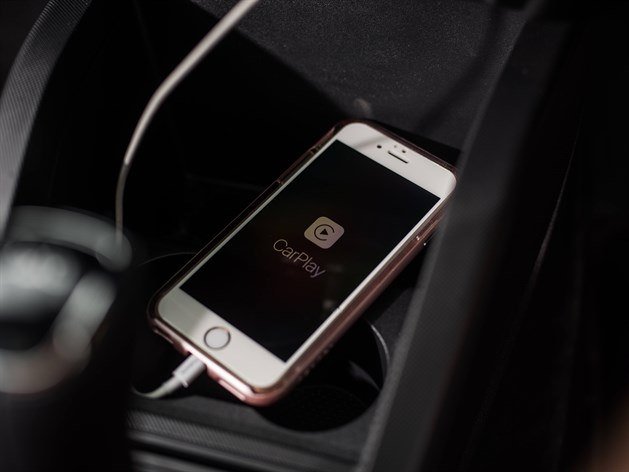
Moments after this photo was taken, CarPlay disconnected
And, after telling this to my partner, I now get texts with the sole intention of them being read to me via CarPlay. On yesterday's drive home I recieved a message that was read to me along the lines of, "your car will self destruct in 3,2,1". So, as you can see, it's clearly being used as was intended when it was designed to help drivers be safer.
The second issue is the jerkiness of the Fabia, which tends to stutter during certain maneuvers. My drive home is 20 miles - or 30 minutes - consisting of 10 minutes urban driving and 20 minutes on rural roads. The DSG is very smooth for the most part and driving in towns at low speed is fine with the start-stop, which is an optional extra.
However, I have to do a three-point-turn on the road outside my house most days and, like when the waiter asks if you want a peek at the dessert menu, the car likes to have a little think before committing. On days when I'm rushing to work, this hesitance can grow a tad irritating.
Apart from these annoyances, the Fabia and I are getting along swimmingly. Something to bear in mind though, especially in summer, is how reflective the touchscreen can be around midday. When the sun is high in the sky, there's almost no chance of you being able to see the screen. But - as we live in England where summer usually lasts about four days - it isn't a huge issue.
A dog's day out
The Fabia gets dog-tested when Georgia takes her Labrador out for a day trip.
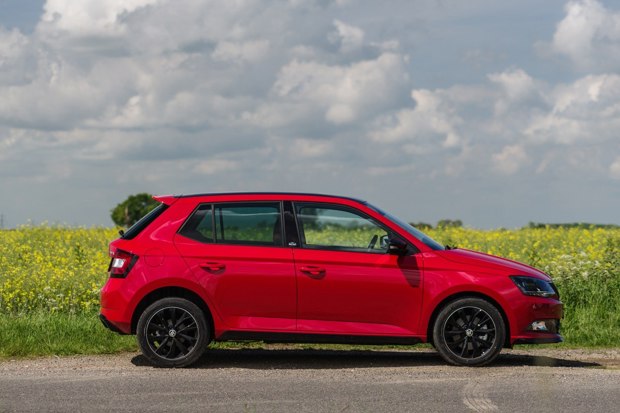
Date: 21 June 2017 | Current mileage: 2178 | Claimed economy: 60.1 | Actual economy: 43.6
I love dogs. I leave work every lunchtime to drive to my grandparents' house and go see my Chocolate Labrador, Hershey. I even brought him to work last week because he was coming to stay at my house for the weekend. But what does this have to do with the Fabia you ask? Patience, young grasshopper.
The Fabia isn't large, surprise surprise. So how easy would it be to fit a large, rambunctious Labrador in the car with me? Well, my dog weighs 42kg. He's overweight and 11 years old, so getting him into a car isn't an easy job. But with a lot of effort and a gracious supply of treats, I got him in the boot.
However, the trip wasn't smooth at all. Monte Carlo is the sportier Fabia trim level, so it was a bumpy ride. Hershey, in his desperation to stick his head out the window, climbed over the back seats and ended up falling into them face first.
So I decided to invest in a dog guard. Which ended up being very useful. If you're interested in reading about it, here's the review of the Travall dog guard.
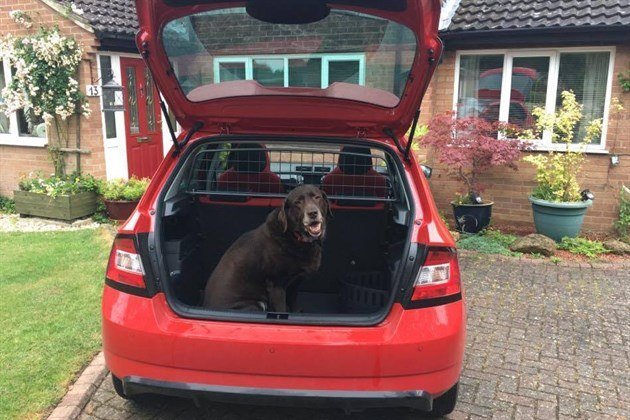
But what I mainly wanted to figure out was whether the Fabia is actually a dog friendly car, not just in terms of its overall size, but also its practicality. Is the boot lip was low enough for my old dog to jump into, for example?
So what did I find out? While the Fabia isn't exactly brimming with space, it is enough just for a short trip. For things like nipping down the road to a local dog park or to the vets, the Fabia does alright. Hershey wasn't too cramped and even had a little lie down after he wore himself out barking.
But the boot lip is fairly high. Now this won't be a problem for younger, agile pups - but for my grey-muzzled, overwieght senior it was a bit too much for his old knees. Which meant I had to lift him in, oh what fun that was.
Now, I don't expect that the Fabia's target audience is dog owners. Nor do I think that people who want to take their dog on long trips would look at getting a Fabia. But if you are thinking about getting a small car and also own a dog, the Fabia offers 305-litres of boot space - making it bigger than both the Volkswagen Polo and SEAT Ibiza. So it can just about do the job.
The Fabia's divisive image
The time has come to discuss why exactly the Fabia struggles to sell itself to young people.
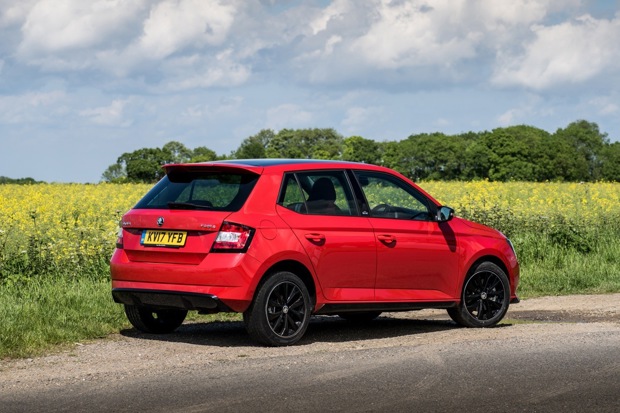
Date: 5 July 2017 | Current mileage: 3246 | Claimed economy: 60.1 | Actual economy: 44.4
The time has come to discuss Skoda's image. These days - as in the last 20 years - Skoda is no longer the butt of many car enthusiasts' jokes.
Over the last few years, Skoda has built its reputation as a reliable, good value brand thanks to cars like the Octavia, the Superb and the recent Kodiaq (Skodiaq?). There's no denying the once laughable brand's relative success, but does that translate to new buyers?
Gone are the jokes about Skoda's being unreliable - you know the ones. "What do you call a Skoda at the top of a hill? A miracle." Or "How do you double the value of a Skoda? Fill it with a tank of petrol." But in my experience with the Fabia, the brand still struggles to sell itself to young people like myself.
So why is that? Well, it's hard to shake an image, especially at a time where image is what a lot of young, new drivers base buying their first car on. Mark wrote about why - despite being a good car, our Car of the Year in fact - the SEAT Ateca struggles with its image.
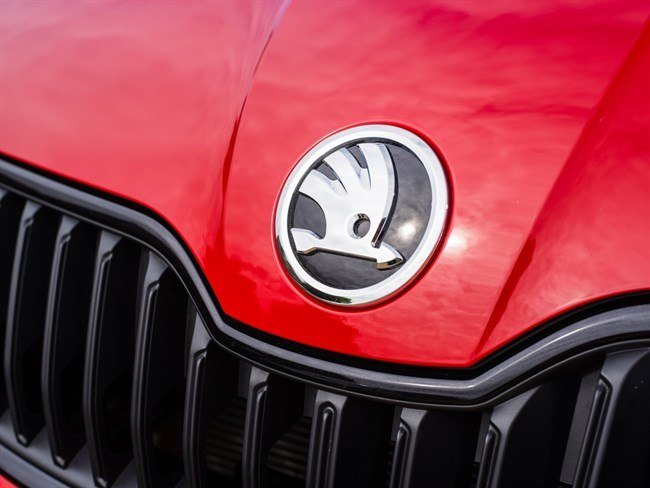
I've told plenty of my 20ish year old friends that a Honda Jazz or a Toyota Yaris are good value, reliable cars with low insurance countless times. Yet the pictures of them smiling next to their brand new Volkswagen Beetle or MINI Cooper are always there, waiting to crop up on my Facebook timeline like a spectre haunting me.
Now, I believe that they ignore my advice not because they don't trust me, but because image says a lot about a person. Especially, for my generation and those born after me (1994 onwards).
What we buy therefore not only represents what we can afford and what we prioritise, but also what lengths we'll go to in order to impress people. That's why sensible, practicle town cars like the Toyota Aygo and the Hyundai i10 are often overlooked in favour of the style-conscious Fiat 500.
Now this isn't meant to bash anyone's taste or their choice in car, to each their own. But, like many others, the Fabia is a good little car that's often - undeservedly - slapped with the image of being an older person's car despite being quite a good ride.
Double trouble: Our red Fabia gets swapped for a green machine
Georgia's 1.2-litre red Fabia gets swapped for a 1.0-litre green machine. But how does it compare?
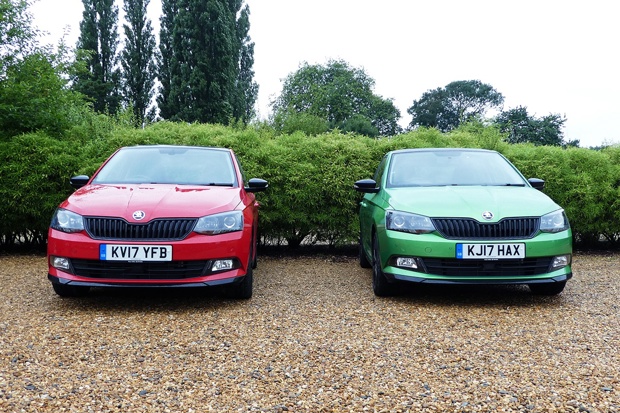
Date: 19 July 2017 | Current mileage: 341 | Claimed economy: 61.4 | Actual economy: 37.6
The grass is always greener, or so they say. The new, green 1.0-litre Fabia is here for the next three months and it'll take some getting used to. Now this isn't Wife Swap, I don't expect my new Fabia to be swapped for something shockingly different like an Audi A7, but there are some changes.
Before we go into that, why did we swap the cars at all? Well, Skoda no longer makes the 1.2 - replacing it with the more economical 1.0 - so it only makes sense to compare them. The two engines have the same power output of 110PS, but the 1.0 has three cylincers instead of four and 25Nm more torque - at 200Nm.
For clarity, and my own amusement, I will from now on refer to the red Fabia as Linda and the green Fabia as Olive. Apart from a dashing new paint colour, a few things have changed inside the car. I opted out of the keyless entry and start system this time around. A mistake, as I've quickly come to realise. I picked the spec for Olive before I'd even driven Linda, meaning that I planned ahead to see what I would or wouldn't miss.
I assumed that because I hadn't experienced keyless entry before, it was the easy choice of something to drop - especially as it costs an eye-watering £320 extra. However I now miss it dearly - mistakenly fumbling around most days trying to start the car without the key, jamming my finger into where the stop/start button used to be. I'm a creature of habit, lesson learnt.
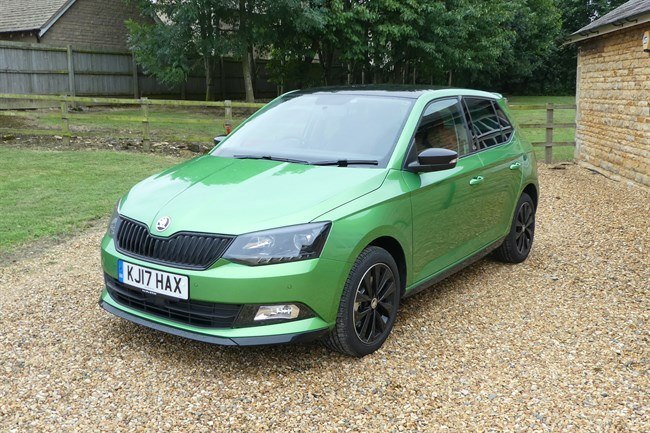
It's not just a different colour. Honestly.
My improving fuel economy was also a tragic casualty in the Fabia Swap of 2017. Linda was hitting 44.4mpg in my last update, but sadly Olive is only delivering a mere 37.6mpg. However, fuel economy often improves the longer you have the car and the 1.0-litre engine is offically more economical than the 1.2. But at 23.8mpg less than its official MPG figure - I'm hoping things pick up soon or I'll be pinching my pennies. Goodbye Friday takeaway.
A nice little suprise is that the Fabia seems more suited to the smaller engine. While both cars are TSI (meaning they have a turbo), the 1.0 feels more at home with the DSG. So when I'm accelerating out of 30mph side roads onto 60mph roads, I don't feel like the automatic gearbox is moving through quicksand trying to catch up with me.
A collegue of mine recently told me that red is the colour people choose because they don't know what to choose. But I disagree, I think red really suits the Fabia - especially with the red details in the Monte Carlo interior. It's going to take some time for me to accept the fact that I'm now known as the 'girl with the green car' in my neighbourhood.
Having a car that looks identical to the last car also has its own set of challenges. In the last few days, I've lost my car a couple of times - spending about 10 minutes searching for a red Fabia when my green machine was mere feet away. My partner also recently tried to get into a red Fabia that didn't belong to me because she forgets it's a different car. Things can only get better I suppose.
How does the Fabia stack up against the UK's favourite small hatchback?
The Skoda Fabia versus the Ford Fiesta. Georgia compares the two very different small hatchbacks.
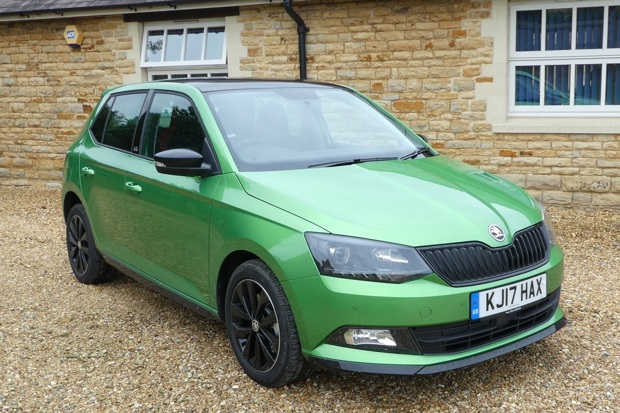
Date: 2 August 2017 | Current mileage: 724 | Claimed economy: 61.4 | Actual economy: 38.7
The small hatchback class is one I'm particularly fond of. All I want in a car is enough space for my shopping, enough power to overtake on country roads and decent fuel economy. It's also a bonus if it's easy to park. Easily pleased, I know.
Well the Fabia fits that bill. Even since I swapped the 1.2-litre red Fabia for the 1.0-litre green Fabia - a change I've hardly noticed - I still really like driving it. While the Fabia isn't the most exciting car, I personally prefer it to the new Ford Fiesta. Cue angry readers who love the Fiesta. But, here's the kicker - for a mere £15 more, the Ford Fiesta offers a better blend of features and quality than my little long-termer. So why do I prefer the Fabia? Let's break it down a bit.
The £18,950 Ford Fiesta I'm comparing to is a 1.0-litre and comes with a range of extras. This includes front and rear parking sensors and cameras, 17-inch alloy wheels, electric rear windows and the Driver Assistance Pack (Pre-collision Assist, Distance Alert and Adaptive Cruise Control). In comparison, the Skoda costs £18,935 and comes with Touchscreen Navigation, a space saver wheel and the Simply Clever Package.
The bog-standard Fiesta comes with Emergency Assist, Keyless Entry, Traffic Sign Recognition and Cruise Control for £16,795. While standard Fabia Monte Carlo comes with 16-inch black alloy wheels, sports suspension, a panoramic roof, parking sensors and stop-start at almost £1000 more (£17,750).
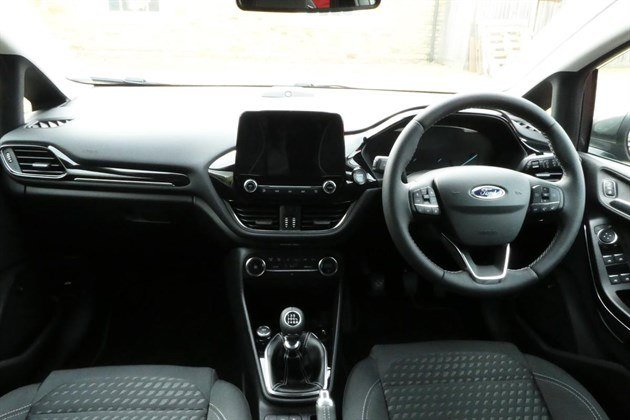
While the interior isn't as vibrant as the Fabia Monte Carlo, it feels more quality
Therefore, the Fiesta (both our model and the standard model) are better value, offering more practical features for less money. And I have to say, Adaptive Cruise Control and Traffic Sign recognition are very helpful, especially if - like me - you have a tendency to creep over the speed limit. I also loved having Keyless Entry back, even if only temporarily.
This eventually boils down to a case of head versus heart. I personally find the Fiesta a little boring, despite it actually being a smarter buy and a very good drive. Maybe that's the monotonous grey versus vibrant green, or maybe it's my bias for the little Fabia - but I actually like having a car that isn't so common.
The Fiesta is the UK's favourite small hatchback, everyone and their mum has one, whereas the Skoda Fabia Monte Carlo is a rarer gem. I actually live near someone else with a 17-plate green Fabia Monte Carlo and we wave to each other everytime we pass on the road. Is that a little strange? Yes. But do I enjoy spotting other Fabia Monte Carlos, yes.
So, I'm not saying everyone should choose a Fabia over a Fiesta. I'm certain no one would do that anyway because the Fiesta deserves its reputation as a great little hatchback. But the Fabia is also a great, underrated little car. While the Fiesta has more features, and the interior feels better quality, it doesn't have the edge in my opinion because the Fabia just feels more fun to drive to me. These cars are pretty different as it goes, but the beauty of such different models is that drivers these days have so much choice when it comes to getting their ideal car.
Simply Clever solutions in the Skoda Fabia
Georgia tests whether the Simply Clever Package is a worthwhile optional extra.
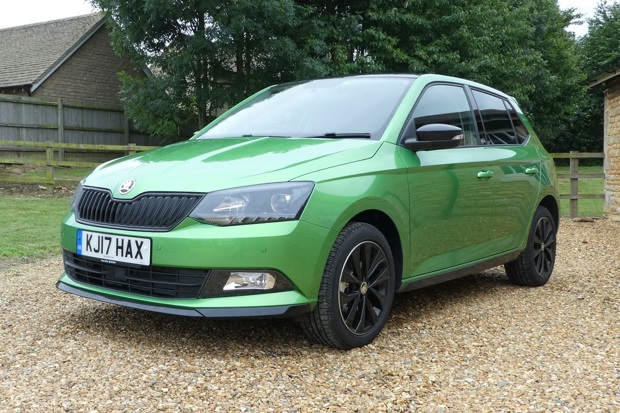
Date: 16 August 2017 | Current mileage: 956 | Claimed economy: 61.4 | Actual economy: 44.2
The Simply Clever package is a £65 extra, which we opted for in our Skoda Fabia. It's definitely clever, but is it worth the money? Well, let's break down exactly what you get.
The package offers an ice scraper in the petrol cap, a ticket holder, various storage compartments, an umbrella beneath the passenger seat and a tiny little waste bin in the driver's side door.
The storage compartments are made up of a phone and small item compartment (which sits in the cup holder), pockets on the sides of the driver and passenger seats and a storage compartment in the boot.
I really like these extra little features, if for nothing more than to make my life that little bit easier. For instance, the ticket holder clips parking tickets to the windscreen, preventing any undeserved parking charges if the ticket blows off the dashboard or is left upside down.
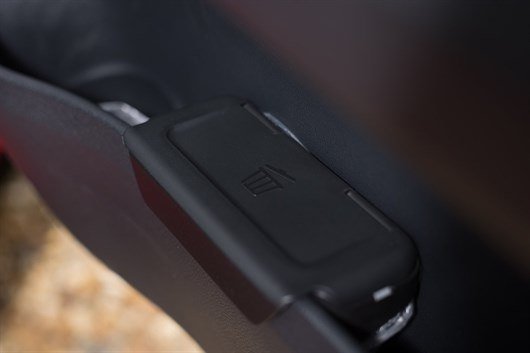
The tiny waste bin comes as part of Skoda's Simply Clever Package
I've also been caught out in the rain various times and have been pretty thankful to have a spare umbrella tucked under the passenger seat. Little things like this go a long way to seperate manufactrers like Skoda from the competition. But, back to the crux of the issue, would I pay £65 extra for these features?
Probably not. They might be Simply Clever, but they simply aren't value for money in my opinion. I use the 'multimedia holder', which sits in the cup holder, to hold my phone almost constantly. And, while I do like my phone not rattling around next to me, it isn't exactly practical to have to remove the holder everytime I want to use the cup holder rather than the bottle holder in the side of the door.
The features are useful, but not always well thought out in terms of practical design. A little bit like the angle of the infotainment screen, which is almost impossible to see when the sun shines in through the sunroof.
At only £20 more than the Simply Clever Package, a space saver steel wheel seems a far more useful purchase. By all means, buy the extras that you want. But if I were to choose one or the other, the spare wheel would get my money.
Why I chose a DSG gearbox in the Skoda Fabia
The good, the bad and the ugly aspects of the Fabia's direct-shift gearbox.
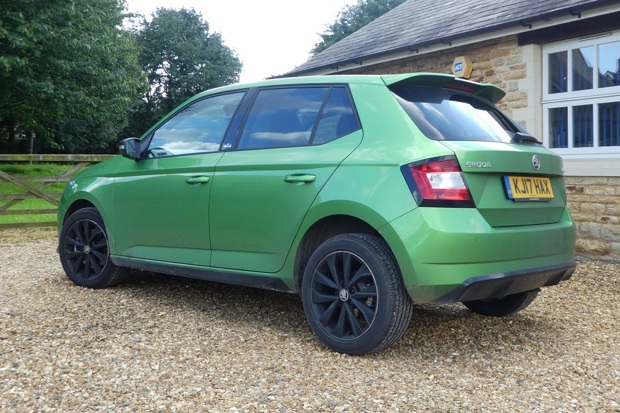
Date: 1 September 2017 | Current mileage: 1647 | Claimed economy: 61.4 | Actual economy: 47.8
I have a manual licence, but for the first year after passing my driving test I drove a 2003 Volkswagen Golf auto (torque converter) because it was the cheapest car going at the time. So when I selected my Fabia, I decided to go for another auto for a bit of comparison.
A dual-clutch transmission, perhaps most famously implemented by Volkswagen with its DSG (direct-shift gearbox), is a little bit complex to explain. In simple terms, it's two seperate manual gearboxes that work together as one unit. By using two independent clutches (although there's no clutch pedal) a DSG can shift more quickly.
People have taken a lot of issue with DSGs in the past, and fairly so - they used to go wrong a lot. But like most things, over time they've improved. Automatic gearboxes used to be known to offer worse performance and fuel economy. However, modern DSGs are more economical than manuals because they utilise a proper clutch, while a torque convertor doesn't - resulting in energy loss.
My Fabia, like most modern autos, allows me to to drive the car as an automated maual. This feature lets me choose exactly when to change gear. I get more control of the car, without the necessity of a clutch pedal, which is perfect for pulling out of junctions quickly or overtaking on twisting country roads.
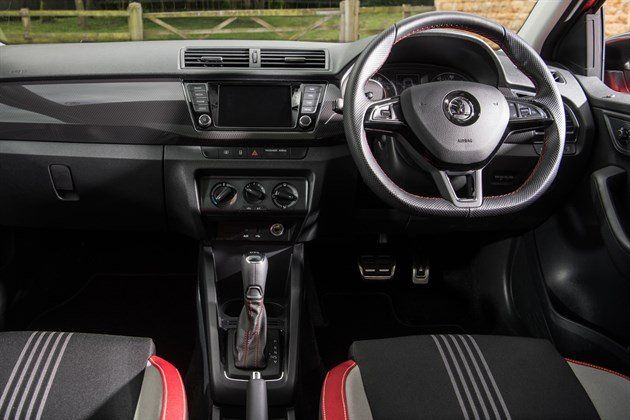
DSGs aren’t perfect though. Torque converters use a fluid connection, which makes them slightly less fuel efficient but it allows them to creep forward naturally from a standstill. This isn’t the case in a DSG because the car's computer takes a few seconds to realise I’ve stepped off the brake before it engages a clutch to mimic the 'creep' function.
There doesn't seem to be constant predictably when pulling away from standstill - sometimes it's smooth, sometimes there's a lag. It can be a bit frustrating when I want the accelerator pedal to react fast, rather than waiting for the car to catch up with my expectations.
Overall, the DSG in my Fabia has worked fairly well. There's a noticable difference compared to the old torque converter in my Golf. The Fabia is far more fuel efficient - although it's also a 1.0-litre, so this is to be expected. The higher gears in my 7-speed DSG helps to boost fuel economy when cruising because the engine is revving less. It also means the car can accelerate harder in lower gears, because closer gearing allows the engine’s power to be used more effectively.
However, it isn't always plain sailing. A DSG car requires a very light touch on the accelerator when reversing. Otherwise, as I've almost done, you risk careering into the car parked behind you. My tactic for not shooting backwards is to put the Fabia in reverse and take my foot off the brake – it’ll eventually edge backwards at a sedate pace.
Safety systems and the Skoda
Georgia gives a rundown of the Fabia's safety features.
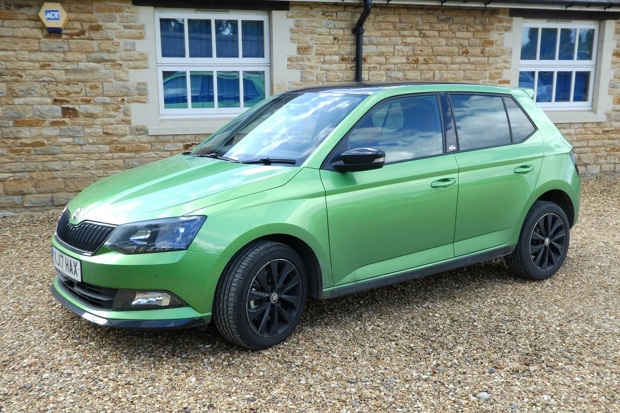
Date: 13 September 2017 | Current mileage: 2357 | Claimed economy: 61.4 | Actual economy: 48.1
Today, we talk about safety. A car's Euro NCAP rating is an important factor when buying a car. Of course there's fuel economy, comfort, reliability etc - but none of that really matters if you crash in a vehicle that'll crumble faster than a twiglet in the rain.
The 2014-onwards Skoda Fabia has a five-star NCAP saftey rating, an improvement on the four-star rating of the previous generation Fabia. So, let's go through some of its safety features and how they stack up to the competition.
Having recently compared our Skoda Fabia Monte Carlo to a new Ford Fiesta, it only makes sense to start with the UK's favourite car. Like the Fabia, the Fiesta has a five-star rating. However, the Fiesta offers five more airbags than the Fabia and Lane Assist as an optional extra.
The Fabia offers Electronic Stability Control (ESC), optional Front Assist (reduces the risk of collisions with objects, vehicles or pedestrians in front) - with the integrated City Emergency Brake function - and Adaptive Cruise Control is also available for the new three-cylinder versions.
But compared to premium cars in this class, the Fabia falls a bit behind. Looking at hatchbacks like the Volkswagen Golf highlight the extra money spent on the Fabia's more expensive counterpart. While the Golf scores a five-star rating, it scores significantly higher in adult ocupant protection and marginally higher in child occupant protection.
Now the Fabia isn't brand new, it was updated in 2014, but neither is the 2012 Golf. So what about a newer model, like the Hyundai i20 or the Mazda 2 - both 2015 incarnations. Both these models are four-star cars, and cost roughly the same price as our Skoda Fabia.
Most hatchbacks are fairly safe. The cars that score three-stars, the Kia Rio and Fiat Tipo, are because of their lack of safety assisstance technology rather than passive equipment like airbags. But generally, modern cars are far safer than, older cars. Hint, hint - the one-star Rover 100.
Generally, the Fabia feels pretty robust. I'm not saying if I were to crash harder than Windows '95 that I'd come out unscathed, but a good safety rating definitely offers some peace of mind.
The Skoda Fabia's uninspired interior
Is is a case of function over flair? Georgia looks into the Skoda Fabia's arguably boring interior.
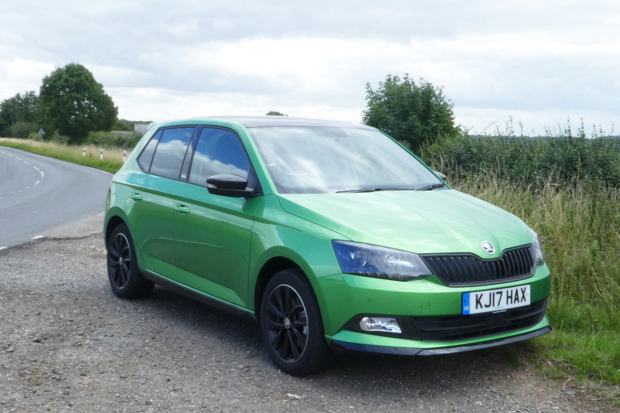
Date: 27 September 2017 | Current mileage: 2986 | Claimed economy: 61.4 | Actual economy: 48.5
The Skoda Fabia doesn't offer all the trimmings that other cars in its class do. When you look inside our Fabia, the first thing you'll notice is the red and black sporty seats of our Monte Carlo trim. Along with 16-inch black alloy wheels and a panoramic roof - it certainly doesn't look boring.
But with lower level trims, I'd be inclined to call it a little drab. While some cars offer style over substance, our Fabia leans more towards function over flair.
Now it isn't a MINI, so you won't get dozens of colour combinations and personalisations with most hatchbacks. But does the lack of personality hold our little Fabia back?
Despite it's lack of soft-touch plastics, like you'd find in it's more more pricey competitor, the Volkswagen Polo - the Fabia still holds it's own. The base model, S trim, comes standard with steel wheels, electrically adjustable and heated door mirrors, front electric windows, DAB radio, a USB port and Bluetooth connectivity.
Upgrade to the SE model and you'll get 15-inch alloys, rear parking sensors and a touchscreen infotainment system. The Skoda Fabia Colour Edition adds colour combinations into the mix, while the top-spec SE-L models come with cruise control, keyless entry and start and climate control.
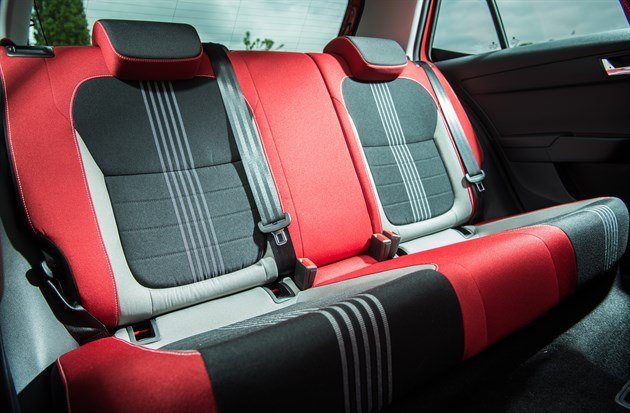
Our Monte Carlo Edition comes with these fancy sporty seats
If anything, the cabin just seems painfully sensible in contrast to the bright interior seats. The shiny plastic surrounding the touchscreen in the centre of the dash is a nice steer away from the rest of the cheap-looking, charcoal plastic that you find around the car.
The temperature controls are easy enough to use, but look slightly sub-standard in a car that was designed with comfort and ease-of-use in mind.
By which I mean, the Fabia is filled with Simpy Clever extras. There's a ice scraper in the filler cap, an umbrella under the seat, a boot holder for the shopping - but that level of thought doesn't seem to have translated to give the Fabia those nice touches inside.
The Skoda Fabia defintely ticks the boxes for comfort, fuel economy and a nice drive - but when it comes to the interior, it's arguably dull. Especially in lower spec models.
Our Skoda Fabia goes home
Our little green Fabia goes back home this week, but what are Georgia's final thoughts?

Date: 10 November 2017 | Current mileage: 3448 | Claimed economy: 61.4 | Actual economy: 47.2
Our Fabia goes back home today, well - back to Milton Keynes anyway. But after six months with our little hatchback, what do we think now it's gone?
To preface this review, it's worth remembering that I had the red, 1.2-litre Fabia for the first three months, which was then replaced by the green, 1.0-litre model. This changeover represents Skoda's actual removal of the 1.2-litre engine from the fleet and, having had both cars, I understand why.
Aside from the obvious improved fuel economy, the 1.0-litre really packs a punch that I didn't feel in the red Fabia. Our 1.0-litre offered the same 110PS, but it felt much sharper on the road. Volkswagen Group's 1.0-litre turbocharged engine really is fantastic.
As for the drive, once I got used to the sports suspension - the Fabia is a speedy little hatchback that offers a decent level of comfort. A three-hour trip in rush hour on A roads felt as easy as my 30 mile commutes across the countryside each day. However, if you spend more than an hour commuting every day, I don't think the Fabia would do much good for your back.
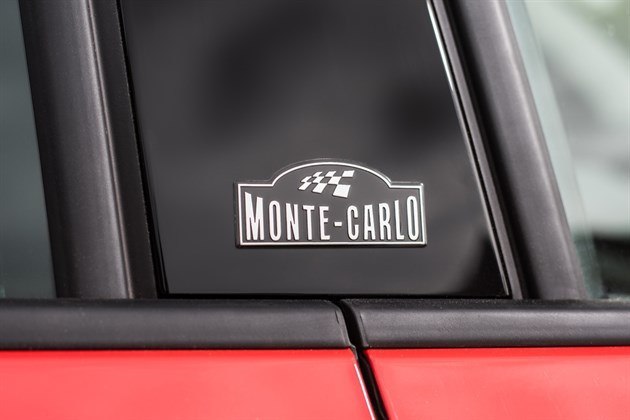
The level of standard equipment in our Monte Carlo trim was good, and I personally like the way it looks - although not everybody shares this view. Apple Play was a touch sensitive and often wouldn't work when I didn't use a genuine Apple cable, but the Navigation and Infotainment system were very simple to use.
The 7-speed DSG worked wonders for me in both models and, having to overtake fairly often on twisting roads, the manual override was a godsend. While the auto was pleasant enough, it can't 'creep' very well. So, when pulling up to a junction or roundabout - the car's computer thinks you're stopping and hesitates right as you want to accelerate.
The most important question really is whether I would buy one myself though. And honestly, I probably would. I'm a fan of small hatchbacks in general. I like the Fabia because it's easy enough to park in the tiny spaces of my village, offers enough room inside and doesn't feel underpowered like many small city cars can.
It also comes with a good amount of standard equipment and it's nice to have a bit of variety in a world of Ford Fiesta and Volkswagen Golf. Especially considering, that a Golf SE 1.0 TSI - that comes with the same 7-speed DSG - will hit your savings quite a bit harder. With the Fabia Monte Carlo, you pay for what you get - not just the brand.
